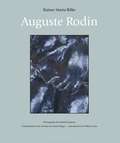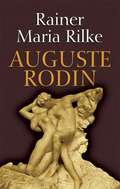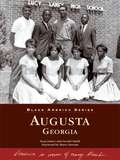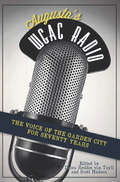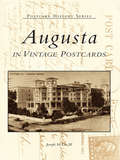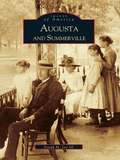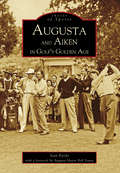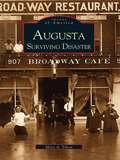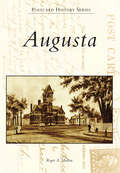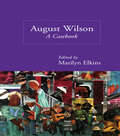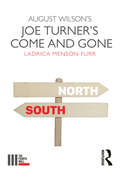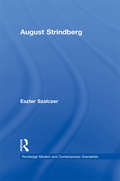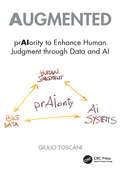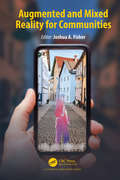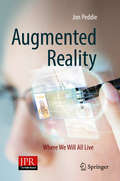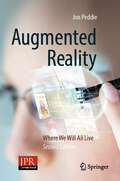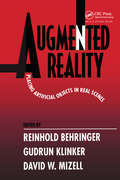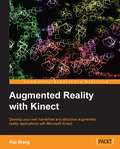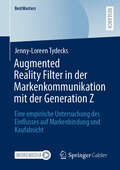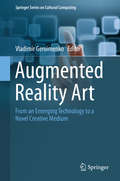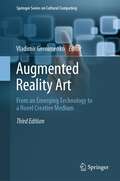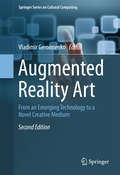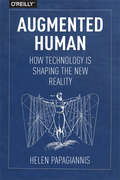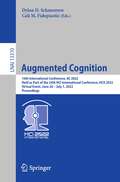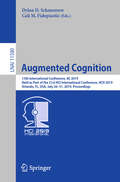- Table View
- List View
Auguste Rodin (Lives Of The Artists Ser.)
by Rainer Maria Rilke William H. Gass Michael Eastman Daniel SlagerSculptor Auguste Rodin was fortunate to have his secretary Rainer Maria Rilke, one of the most sensitive poets of our time. These two pieces discussing Rodin¢s work and development as an artist are as revealing of Rilke as they are of his subject. Written in 1902 and 1907, these essays mark the entry of the poet into the world of letters. Rilke¢s description of Rodin reveals the profound psychic connection between the two great artists, both masters of giving visible life to the invisible. Michael Eastman¢ evocative photographs of Rodin¢s sculptures shed light on both Rodin¢s art and Rilke¢s thoughts and catapult them into the 21st century.
Auguste Rodin (Dover Fine Art, History of Art)
by Rainer Maria RilkeDuring the early 1900s, the great German poet lived and worked in Paris with Auguste Rodin. In a work as revealing of its author as it is of his famous subject, Rainer Maria Rilke examines Rodin's life and work, and explains the often elusive connection between the creative forces that drive timeless literature and great art.Rilke served for several years as Rodin's secretary — living in the sculptor's workshops, watching the shaping of his creations, and discussing his views and ideas. Written in 1903 and 1907, these essays about the master's work and development as an artist mark Rilke's entry into the world of letters. Rodin himself paid the poet the ultimate tribute, declaring these meditations the supreme interpretation of his work. This excellent translation, complemented by 33 illustrations, will fascinate students of literature, philosophy, and art history.
Augusta, Georgia (Black America Series)
by Sean Joiner Marva Stewart Gerald SmithFilled with remarkable vintage photographs, Black America: Augusta, Georgia captures the essence of the African-American heritage in this historic Southern community. The Garden City has produced a wide variety of intellectual and political pioneers, including a handful of educators who were instrumental in the pivotal Brown versus Board of Education case. Within the pages of this volume, their stories unfold.
Augusta's WGAC Radio: The Voice of the Garden City for Seventy Years
by Debra Reddin van Tuyll Scott HudsonWGAC is the No. 1-rated radio station in Augusta. It has weathered the transition in American radio from local stations with local programming to corporately owned stations that feature syndicated programming, and it has been able to do so without giving up its local character. As a news-talk radio station today, WGAC is the first place most Augustans go to find out what is happening nationally and locally, and its morning drive-time and afternoon drive-time show hosts and news personnel are some of the most beloved and respected media figures in Augusta. This book will trace the history of this community landmark from its infancy to its status today as a community institution. It will highlight the people who have created the programming for which WGAC is known and also the people like James Brown who have used the station to launch important careers. The book will also discuss Fuqua's broadcasting technology innovations such as advances in acoustics engineering and early television technology. The history will also cover the station's decades-long support of the Master's Golf Tournament, which has led to it becoming the official radio station of the Master's.
Augusta in Vintage Postcards (Postcard History Series)
by Joseph M. Lee IIIIn the early 1900s, America was swept up in the postcard craze. All over the country, people seized on these charming snapshots of life as a means of keeping in touch with friends and family, as well as seeing strange and exciting parts of the world.
Augusta and Summerville
by Joseph M. Lee IIIAugusta and Summerville showcases rare nineteenth-century stereoviews and photographs from the extensive collection of Joseph M. Lee III and the Augusta Museum of History, spanning a 41-year period from 1859 to 1900. The engaging images within these pages were captured on film by some of Augusta's earliest photographers, including J.W. Perkins, JohnUsher Jr., J.A. Palmer, and H.C. Hall, among others. Most of the images have never been published and provide an unusually valuable source of information about Augusta and its environs. Known the world round for its pristine landscapes and "Garden City" charm, Augusta has always been a photographer's dream. Lush, verdant scenes recall a city yet unmarked by the scars of expansion, still enjoying the tranquility of life in the Old South. Views of early businesses and homes on Broad and Greene Streets, the flood of 1888, local monuments, historic churches and cemeteries, pioneering schools, the early cotton crop, and area waterwaysall contribute to this visual journey. The reader will delight in scenes of yesteryear, diving deep into the annals of one of Georgia's most beloved cities.
Augusta and Aiken in Golf's Golden Age (Images of Sports)
by Stan Byrdy Augusta Mayor YoungThe game of golf got its start in the Southeastern United States in 1892 on four holes with sand greens at Palmetto Golf Club in Aiken, South Carolina. Within five years, Palmetto had expanded to eighteen holes and the first nine-hole course in neighboring Augusta, Georgia was designed at the Hotel Bon Air. For half a century, the Augusta-Aiken area flourished as the winter destination of choice for the rich, famous, and powerful in America. Presidents Taft, Harding, and Eisenhower vacationed here. Baseball great Ty Cobb bought a home in Augusta's quaint Summerville neighborhood. It was here that Bobby Jones began the improbable journey towards a Grand Slam, then built his dream golf course. By the turn of the century, winter tourism and grand resort hotels in the Augusta-Aiken area were well established. A favorable winter climate and easy rail access drew vacationers to Highland Park Hotel (1866), Willcox Hotel (1898), and Park in the Pines (1900) in Aiken; Hotel Bon Air (1890) and Partridge Inn (1913) in Augusta; and Hampton Terrace Hotel and Golf Club (1903) in North Augusta. Resorts in Florida and the growth of the air travel industry later coupled to mark the area's decline in winter tourism, but not before Augusta-Aiken's place in golf history was secure. In this unique volume, vintage images and accompanying text recall the unfo rgettable legends, the meticulously maintained courses, and all of the grandeur associated with the game.
Augusta Surviving Disaster: Surviving Disaster (Images of America)
by Misty A. TilsonAugusta: Surviving Disaster allows readers to glimpse the changes that mother nature and human error have wrought on the landscape and design of the "Garden City." These disasters did not only alter the city's landscape; many were the impetus for change in Augusta. The ravaging floods led to the construction of the levee along the Savannah River in 1919, to prevent flooding, and spurred the creation of the Clark Hill Dam and Reservoir. Within this volume, readers will get a glimpse of the damagecaused by the floodwaters of the Savannah River and the Augusta Canal. The remains of St. Paul's Episcopal Church, as well as other homes and businesses, after the Great Fire of 1916 are captured. Historic photographs reveal the damaged remains of the Lower Market after the 1878 tornado. Culled from the extensive collection of the Augusta Museum of History and the personal collection ofJoseph M. Lee III, these images provide testimony to the resiliency of the human spirit and the courage to move forward and rebuild. The citizens of Augusta have a long history of uniting for the common good, and this volume is a tribute to those who overcameobstacles to create the thriving community that exists today.
Augusta (Postcard History Series)
by Roger A. MadoreBuilt in 1754 on the eastern bank of the Kennebec River, Fort Western became one of the first permanent settlements in what would eventually become Augusta and, in 1827, the capital of Maine. Through innovations in publishing by Gannett & Morse and Vickery & Hill, textiles by the Edwards Manufacturing Company, and lumber production along the Kennebec, Augusta thrived and prospered. Water Street flourished into the business and cultural center of the city, while Green and Winthrop Streets became some of the area's most opulent residential neighborhoods. A trolley system and the Maine Central Railroad station tied Augusta to surrounding communities and allowed visitors to come from far and wide and spend many a night at the famed Augusta House.
August Wilson: A Casebook (Casebooks on Modern Dramatists #Vol. 15)
by Marilyn ElkinsFirst Published in 2000. Routledge is an imprint of Taylor & Francis, an informa company.
August Wilson's Joe Turner's Come and Gone (The Fourth Wall)
by Ladrica Menson-Furr"Herald Loomis, you shining! You shining like new money!" - Bynum Walker August Wilson considered Joe Turner’s Come and Gone (1984) to be his favourite play of the ten in his award-winning Pittsburgh Cycle. It is a drama that truly examines the roots, crossroads, and intersections of African, American, and African American culture. Its characters and choral griots interweave the intricate tropes of migration from the south to the north, the effects of slavery, black feminism and masculinity, and Wilson's theme of finding one's "song" or identity. This book gives readers an overview of the work from its inception on through its revisions and stagings in regional theatres and on Broadway, exploring its use of African American vernacular genres—blues music, folk songs, folk tales, and dance—and nineteenth-century southern post-Reconstruction history. Ladrica Menson-Furr presents Joe Turner's Come and Gone as a historical drama, a blues drama, an American drama, a Great Migration drama, and the finest example of Wilson's gift for relocating the African American experience in urban southern cities at the beginning and not the end of the African American experience.
August Strindberg (Routledge Modern and Contemporary Dramatists)
by Eszter SzalczerDramatist, theatre practitioner, novelist, and painter, August Strindberg’s diverse dramatic output embodied the modernist sensibility. He was above all one of the most radical innovators of Western theatre. This book provides an insightful assessment of Strindberg’s vital contribution to the dramatic arts, while placing his creative process and experimental approach within a wider cultural context. Eszter Szalczer explores Strindberg’s re-definition of drama as a fluid, constantly evolving form that profoundly influenced playwriting and theatrical production from the German Expressionists to the Theatre of the Absurd. Key productions of Strindberg’s plays are analysed, examining his theatre as a living voice that continues to challenge audiences, critics, and even the most innovative directors. August Strindberg provides an essential and accessible guide to the playwright’s work and illustrates the influence of his drama on our understanding of contemporary theatre.
Augmented: prAIority to Enhance Human Judgment through Data and AI
by Giulio ToscaniIn a world where artificial intelligence is reshaping industries, how can we ensure that AI enhances human skills rather than replacing them? This book offers readers an accessible and insightful guide to the positive potential of AI for human augmentation.Drawing from consultations with 150 AI experts from across 50 countries, Augmented introduces the concept of "prAIority", which connects three essential pillars: data, AI systems, and human judgment. It examines how data fuels innovation, the intricacies of designing and refining AI systems, and the critical role of human expertise in harnessing AI’s strengths. Breaking down complex ideas, this book equips readers with the knowledge to understand how AI can be integrated into their decision-making processes, ultimately empowering them to achieve better outcomes in diverse fields such as healthcare, design, and business.With a focus throughout on human–AI collaboration rather than automation and on seamless integration—for smarter, faster decisions, and innovation—this is a must-read book for professionals looking to enhance their skills and stay ahead in the AI-driven future as well as curious beginners seeking a clear framework.
Augmented and Mixed Reality for Communities
by Joshua A. FisherUsing mixed and augmented reality in communities is an emerging media practice that is reshaping how we interact with our cities and neighbors. From the politics of city hall to crosswalks and playgrounds, mixed and augmented reality will offer a diverse range of new ways to interact with our communities. In 2016, apps for augmented reality politics began to appear in app stores. Similarly, the blockbuster success of Pokémon Go illustrated how even forgotten street corners can become a magical space for play. In 2019, a court case in Milwaukee, Wisconsin, extended first amendment rights to augmented reality. For all the good that these emerging media provide, there will and have been consequences. Augmented and Mixed Reality for Communities will help students and practitioners navigate the ethical design and development of these kinds of experiences to transform their cities. As one of the first books of its kind, each chapter in the book prepares readers to contribute to the Augmented City. By providing insight into how these emerging media work, the book seeks to democratize the augmented and mixed reality space.Authors within this volume represent some of the leading scholars and practitioners working in the augmented and mixed reality space for civic media, cultural heritage, civic games, ethical design, and social justice. Readers will find practical insights for the design and development to create their own compelling experiences. Teachers will find that the text provides in-depth, critical analyses for thought-provoking classroom discussions.
Augmented Reality: Where We Will All Live
by Jon PeddieThis book provides an in-depth exploration of the field of augmented reality (AR) in its entirety and sets out to distinguish AR from other inter-related technologies like virtual reality (VR) and mixed reality (MR). The author presents AR from its initial philosophies and early developments, to its current technologies and its impact on our modern society, to its possible future developments; providing readers with the tools to understand issues relating to defining, building, and using our perception of what is represented in our perceived reality, and ultimately how we assimilate and react to this information. Augmented Reality: Where We Will All Live can be used as a comprehensive guide to the field of AR and provides valuable insights for technologists, marketers, business managers, educators and academics who are interested in the field of augmented reality; its concepts, history, practices and the science behind this rapidly advancing field of research and development.
Augmented Reality: Where We Will All Live
by Jon PeddieThis book provides an in-depth exploration of the field of augmented reality (AR) in its entirety and sets out to distinguish AR from other inter-related technologies like virtual reality (VR), mixed reality (MR) and extended reality (XR). The author presents AR from its initial philosophies and early developments, and in this updated 2nd edition discusses the latest advances and the ramifications they bring and the impact they have on modern society. He examines the new companies that have entered the field and those that have failed or were acquired giving a complete history of AR progress. He explores the possible future developments providing readers with the tools to understand issues relating to defining, building, and using their perception of what is represented in their perceived reality, and ultimately how we assimilate and react to this information. In Augmented Reality: Where We Will All Live 2nd Edition, Jon Peddie has amassed and integrated a corpus of material that is finally in one place. It will serve as a comprehensive guide and provide valuable insights for technologists, marketers, business managers, educators and academics who are interested in the field of augmented reality, its concepts, history, practices, and the science behind this rapidly advancing field of research and development.
Augmented Reality: Placing Artificial Objects in Real Scenes
by Gudrun Klinker Reinhold Behringer David W. MizellThis book presents a variety of techniques that combine computer-generated images and other objects with real scenes, creating augmented reality. This work provides an excellent snapshot of the current state of augmented reality research and its latest applications to industry. Using computer vision, graphics, and signal processing, augmented reali
Augmented Reality with Kinect
by Rui WangThis book is a mini tutorial with plenty of code examples and strategies to give you many options when building your own applications.This book is meant for readers who are familiar with C/C++ programming and want to write simple programs with Kinect. The standard template library can also be used as it is simple enough to understand.
Augmented Reality Filter in der Markenkommunikation mit der Generation Z: Eine empirische Untersuchung des Einflusses auf Markenbindung und Kaufabsicht (BestMasters)
by Jenny-Loreen TydecksDie Generation Z stellt aufgrund ihrer signifikanten Kaufkraft eine wichtige Zielgruppe für Unternehmen dar. Unternehmen müssen daher Kommunikationsstrategien entwickeln, um die Aufmerksamkeit dieser Generation zu gewinnen und sich von der Konkurrenz abzuheben. Hier stoßen Unternehmen jedoch auf große Schwierigkeiten, denn sie treffen bei der Gen Z auf zunehmend gering involvierte Kunden, die sich selten an bestimmte Marken binden. In der Wissenschaft ist man sich deshalb einig, dass Unternehmen neue Wege der Kommunikation gehen und emotionale Markenerlebnisse schaffen müssen, um die Generation Z an sich binden zu können. Da die sozialen Medien eine wichtige Rolle im Leben der Generation Z spielen, stellt insbesondere Instagram einen bedeutenden Kommunikationskanal dar. Hier müssen Unternehmen ansetzen, um die Aufmerksamkeit der Gen Z für sich zu gewinnen. Vor diesem Hintergrund wird in der vorliegenden Studie untersucht, inwieweit Augmented Reality Filter als neue Form digitaler Kommunikation dafür geeignet sind, die Markenbindung und die Kaufabsicht der Generation Z positiv zu beeinflussen.
Augmented Reality Art: From an Emerging Technology to a Novel Creative Medium (Springer Series on Cultural Computing)
by Vladimir GeroimenkoThis is the first ever book on augmented reality art. It is written by a team of world-leading artists, researchers and practitioners, pioneering in the use of augmented reality technology as a novel artistic medium. The book explores a wide range of major aspects of augmented reality art and its enabling technology. It is intended to be a starting point and essential reading not only for artists, researchers and technology developers, but also for students (both graduates and undergraduates) and everyone who is interested in emerging augmented reality technology and its current and future applications in art.
Augmented Reality Art: From an Emerging Technology to a Novel Creative Medium (Springer Series on Cultural Computing)
by Vladimir GeroimenkoThis is the third edition of the first ever book to explore the exciting field of augmented reality art and its enabling technologies. The new edition has been thoroughly revised and updated, with 9 new chapters included. As well as investigating augmented reality as a novel artistic medium, the book covers cultural, social, spatial and cognitive facets of augmented reality art. It has been written by a virtual team of 33 researchers and artists from 11 countries who are pioneering in the new form of art, and contains numerous colour illustrations showing both classic and recent augmented reality artworks.Intended as a starting point for exploring this new fascinating area of research and creative practice, it will be essential reading not only for artists, researchers and technology developers, but also for students (graduates and undergraduates) and all those interested in emerging augmented reality technology and its current and future applications in art.
Augmented Reality Art: From An Emerging Technology To A Novel Creative Medium (Springer Series on Cultural Computing)
by Vladimir GeroimenkoThis is the second edition of the first ever book to explore the exciting new field of augmented reality art and its enabling technologies. The new edition has been thoroughly revised and updated, and contains 5 new chapters. As well as investigating augmented reality as a novel artistic medium the book covers cultural, social, spatial and cognitive facets of augmented reality art. Intended as a starting point for exploring this new fascinating area of research and creative practice it will be essential reading not only for artists, researchers and technology developers, but also for students (graduates and undergraduates) and all those interested in emerging augmented reality technology and its current and future applications in art.
Augmented Human: How Technology Is Shaping the New Reality
by Helen PapagiannisAugmented Reality (AR) blurs the boundary between the physical and digital worlds. In AR’s current exploration phase, innovators are beginning to create compelling and contextually rich applications that enhance a user’s everyday experiences. In this book, Dr. Helen Papagiannis—a world-leading expert in the field—introduces you to AR: how it’s evolving, where the opportunities are, and where it’s headed.If you’re a designer, developer, entrepreneur, student, educator, business leader, artist, or simply curious about AR’s possibilities, this insightful guide explains how you can become involved with an exciting, fast-moving technology.You’ll explore how:Computer vision, machine learning, cameras, sensors, and wearables change the way you see the worldHaptic technology syncs what you see with how something feelsAugmented sound and hearables alter the way you listen to your environmentDigital smell and taste augment the way you share and receive informationNew approaches to storytelling immerse and engage users more deeplyUsers can augment their bodies with electronic textiles, embedded technology, and brain-controlled interfacesHuman avatars can learn our behaviors and act on our behalf
Augmented Cognition: 16th International Conference, AC 2022, Held as Part of the 24th HCI International Conference, HCII 2022, Virtual Event, June 26 – July 1, 2022, Proceedings (Lecture Notes in Computer Science #13310)
by Dylan D. Schmorrow Cali M. FidopiastisThis book constitutes the refereed proceedings of the 16th International Conference on Augmented Cognition, AC 2022, held as part of the 23rd International Conference, HCI International 2022, which was held virtually in June/July 2022.The total of 1271 papers and 275 posters included in the HCII 2022 proceedings was carefully reviewed and selected from 5487 submissions. The AC 2022 proceedings aims to develop adaptive systems capable of extending the information management capacity of individuals through computing technologies and offers a broad range of theoretical and applied issues related to Augmented Cognition and its applications.
Augmented Cognition: 13th International Conference, AC 2019, Held as Part of the 21st HCI International Conference, HCII 2019, Orlando, FL, USA, July 26–31, 2019, Proceedings (Lecture Notes in Computer Science #11580)
by Dylan D. Schmorrow Cali M. FidopiastisThis book constitutes the refereed proceedings of the 13th International Conference on Augmented Cognition, AC 2019, held as part of the 21st International Conference on Human-Computer Interaction, HCII 2019, in Orlando, FL, USA in July, 2019. The 1274 full papers and 209 posters presented at the HCII 2019 conferences were carefully reviewed and selected from 5029 submissions. The papers cover the entire field of human-computer interaction, addressing major advances in knowledge and effective use of computers in a variety of applications areas. The papers in this volume are organized in the following topical sections: cognitive modeling, perception, emotion and interaction; human cognition and behavior in complex tasks and environments; brain-computer interfaces and electroencephalography; and augmented learning.
